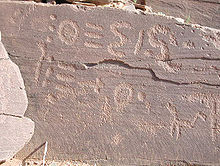Libyan script
The Libyan script (also called Old Libyan or Numidian ) is an alphabet script dating from around the 3rd century BC. It was used for the Libyan language in much of North Africa until the 3rd century AD . It was a consonant writing that usually did not mark vowels . The exception is a grapheme that stands for a vowel, usually in the final position. Also, the Gemination was not identified. The direction of the writing was not regulated uniformly, but often ran from top to bottom.
history
The Libyan script probably developed on the basis of the Phoenician-Punic script . This is indicated by its character as a consonant script. On the other hand, the character shapes cannot be derived from Phoenician or Punic and must therefore have been a local innovation. According to Robert Kerr, the time of Massinissa's reign is most likely to be considered for the development of a Libyan script of its own. The Tifinagh script , used today by the Tuareg , developed from the Libyan script , the name of which could indicate the Phoenician origin.
Dissemination and deciphering
So far, about 1,200 inscriptions are known that have been found in the area between the Mediterranean, Nile, Niger and Canary Islands. A particularly high density is in present-day Tunisia and the neighboring areas of Algeria . Two large groups can be distinguished: an eastern variant, whose western border is in Algeria, and a western form, which has more characters than the eastern variant. While the western script has only been partially deciphered, the sound values of the characters of the eastern variety could be determined almost completely. Decisive for the deciphering was the bilingual on the pillar tomb in Thugga in today's Tunisia from the 2nd century BC. Chr.
Libyan-Berber script
The western variant is also known as the "Libyan-Berber script". About 100 testimonies of her are known in Morocco , which were also placed on steles .
literature
- Jean-Baptiste Chabot: Recueil des inscriptions libyques. Imprimerie Nationale, Paris 1940.
- G. Camps: Écriture libyque. In: Encyclopédie Berbère. Aix-en-Provence 1984, pp. 2564-2573. ISBN 2-85744-201-7
- Robert M. Kerr: Some Thoughts on the Origins of the Libyco-Berber Alphabet. In: Harry Stroomer u. a. (Ed.): Ètudes berbères V. Essais sur des variations dialectales et autres articles. Actes du «5. Bayreuth-Frankfurt-Leiden Colloquium on Berberology », Leiden, 8–11 October 2008. Cologne 2010, pp. 41–68. LINK
